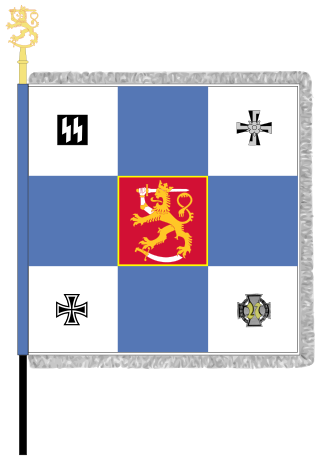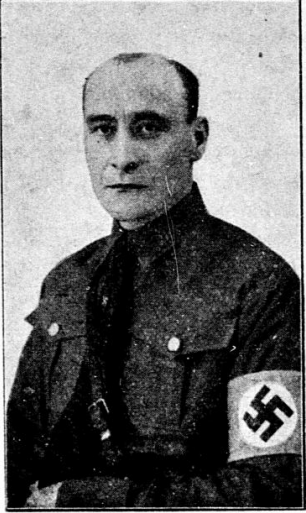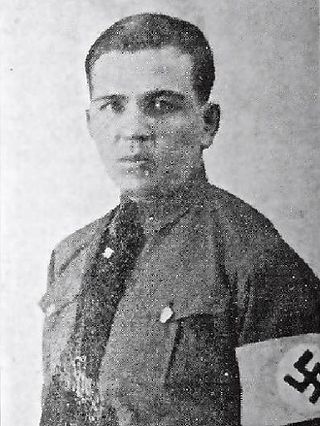Related Research Articles

Pehr Evind Svinhufvud af Qvalstad was the third president of Finland from 1931 to 1937. Serving as a lawyer, judge, and politician in the Grand Duchy of Finland, which was at that time an autonomous state within the Russian Empire, Svinhufvud played a major role in the movement for Finnish independence. He was the one who presented the Declaration of Independence to the Parliament.

From 1941 to 1943, 1,408 Finns volunteered for service on the Eastern Front of World War II in the Waffen-SS, in units of the SS Division Wiking. Most of these volunteers served as motorized infantry in the Finnish Volunteer Battalion of the Waffen-SS. The unit was disbanded in mid-1943 as the volunteers' two-year commitment had expired and the Finnish government was unwilling to allow more men to volunteer. In 1944-1945 a company sized unit of Finnish defectors recruited to the SS continued fighting alongside Germany.

Senate Square presents Carl Ludvig Engel's architecture as a unique allegory of political, religious, scientific and commercial powers in the centre of Helsinki, Finland.

Carl Johan Alexis Enckell was a Finnish politician, diplomat, officer and businessman.

Erkki Aleksanteri Räikkönen was a Finnish nationalist leader.

The Nordic Resistance Movement is a pan-Nordic neo-Nazi movement in the Nordic countries and a political party in Sweden. Besides Sweden, it is established in Norway, Denmark and Iceland, and formerly in Finland before it was banned in 2019. Terrorism expert Magnus Ranstorp has described the NRM as a terrorist organization due to their aim of abolishing democracy along with their paramilitary activities and weapons caches. In 2022, some members of the United States Congress began calling for the organization to be added to the United States Department of State list of Foreign Terrorist Organizations.

The Stadin Derby, or The Helsinki Derby, is the name for a Helsinki association football fixture played between HIFK Fotboll and HJK Helsinki. The name of the derby derives from the common slang word nickname for Helsinki (Stadi), widely used by the locals. Both the teams play at the highest level of football in Finland, in Veikkausliiga. Before 2015, the clubs had not faced each other at the highest level since 1972 when HIFK got relegated from the top league, which was then known as Mestaruussarja.

Karl Algot Jansson was a Finnish journalist and radical right-wing activist.

Väinö David Lassila was a Finnish physician, anatomist and anthropologist who was a Professor of Anatomy at the University of Helsinki. He was the leading authority of the Finnish racial studies, but since the mid-1930s, Lassila dissociated himself from racial theories and became one of the prominent figures of Finland's human rights movement.
Anarchism in Finland dates back to the early revolutionary movements of the 20th century, seeing organized activity begin in the 1960s.

In Finland, the far right was strongest in 1920–1940 when the Academic Karelia Society, Lapua Movement, Patriotic People's Movement (IKL) and Export Peace operated in the country and had hundreds of thousands of members. In addition to these dominant far-right and fascist organizations, smaller Nazi parties operated as well.

Hjalmar Thorvald Oljemark was a Finnish manor owner and a Nazi. He was one of the founders of the Nazi party called the Finnish People's Organisation and also worked as its propaganda chief and editor-in-chief of the party's newspapers.
The Party of Finnish Labor was a Finnish far-right party operating in the 1930s and 1940s, led by engineer Niilo Rauvala. The party's motto was: "Finland into a great and rich nation state". In 1940s, the organization was known as the New Finnish Party. The party was dissolved on 18 January 1945 as contrary to Article 21 of the Moscow Armistice, which forbade fascist parties.

Teo Kaarlo Snellman was a Finnish Nazi, embassy counselor, translator, and vegetarian. From 1940 to 1944, Snellman headed the Finnish National Socialist Labor Organisation. Snellman was the grandson of Johan Vilhelm Snellman. Teo considered his grandfather Johan Vilhelm and Eino Leino, Väinämöinen and Mikael Agricola to be Finland's first National Socialists.
The Pro-German resistance movement in Finland was set up during the latter stages of the Second World War after the Moscow Armistice by Nazi Germany and the extreme right in Finland, who prepared for armed struggle against the expected Soviet occupation. Germany funded the activities and provided the necessary training. The project was separate from the plans drawn up by Finnish chief of staff officers in the summer of 1944 for the transition to guerrilla warfare. When there was no occupation, propaganda and smuggling hundreds of people out of Finland became the principal activity of the organization. After the defeat of Germany, the movement did not disintegrate but operated in Finland for several more years. Some members of the movement were caught, and 11 were convicted of treason in 1946.
Niilo Vilho Rauvala was a Finnish engineer and the chairman of the far-right Lalli Alliance of Finland and the Nazi Party of Finnish Labor in the 1930s and 1940s.
Antti Salamaa, formerly Salomaa and before that Mielonen was a Finnish sailor and former police officer who became famous in 1929 when he was the secretary of the Lalli Alliance of Finland.
Front Soldier League was a Finnish civil war White Guard veteran organization between the years 1929 and 1944, which also had extreme right-wing political objectives. In the early 1930s, it had close links with the Lapua movement, in which the leaders of the League played an important role. The Front Soldier League was abolished in 1944 on the basis of the Moscow peace treaty, which forbade fascist organizations. It had a sister organization for women, the Front Soldier Women's League, which was also disbanded.
Yrjö Wilhelm Jalander was a Finnish pharmacist and the founder of Oy Merijal Ab and the pharmaceutical factory Leon.
Eugenie Lisitzin was a Finnish physical oceanographer active in the mid-20th century. She was the first woman in Finland to earn a PhD in physics (1938) and join the Finnish Society of Sciences and Letters (1960). She also was the first acting director of a scientific department of the Finnish government.
References
- 1 2 3 Rafael Olinin GeneaNet-sivusto : John Rosberg
- ↑ Helsingin käsikeskuspuhelimet yhdistetty automaattikeskuksiin, Uusi Suomi 30.04.1929 nro 116, s. 7, Kansalliskirjaston Digitoidut aineistot
- ↑ Merja Kihl - Ari Mononen : Tekniikkaa ja tarinoita Runeberginkadulla : Töölön puhelinkeskusrakennus 1915-2008, sivu 25, 27
- 1 2 Roselius, Aapo – Silvennoinen, Oula – Tikka, Marko: ”Kerran Suomessa taistellaan – suomalainen fasismi ja sota”, Suomalaiset fasistit – mustan sarastuksen airuet, s. 335,347,348,398. Helsinki: WSOY, 2016. ISBN 978-951-0-42327-1.
- ↑ Tommi Kotonen : Kampen för den europeiska livsstilen. Drag inom den finlandssvenska högerextrema tankevärlden efter andra världskriget, Historiska och litteraturhistoriska studier Vol 92(2017)
- ↑ Veren ääni" jo Suomessakin, Helsingin Sanomat, 01.05.1936, nro 117, s. 8, Kansalliskirjaston digitaaliset aineistot